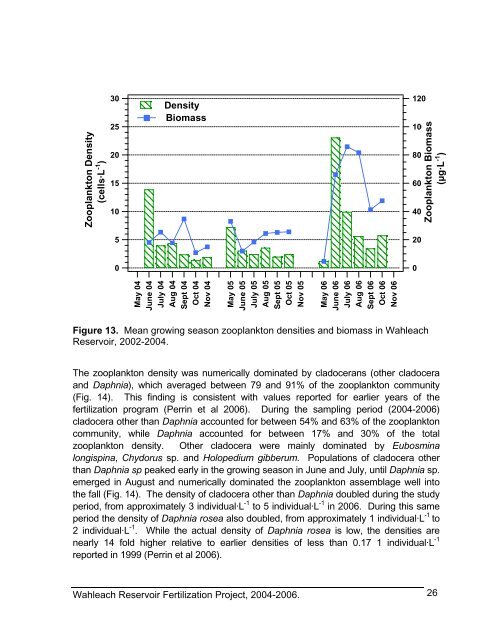Wahleach Project Water Use Plan Wahleach Reservoir ... - BC Hydro
Wahleach Project Water Use Plan Wahleach Reservoir ... - BC Hydro
Wahleach Project Water Use Plan Wahleach Reservoir ... - BC Hydro
You also want an ePaper? Increase the reach of your titles
YUMPU automatically turns print PDFs into web optimized ePapers that Google loves.
Zooplankton Density<br />
(cells·L -1 )<br />
30<br />
25<br />
20<br />
15<br />
10<br />
5<br />
0<br />
Density<br />
Biomass<br />
May 04<br />
June 04<br />
July 04<br />
Aug 04<br />
Sept 04<br />
Oct 04<br />
Nov 04<br />
May 05<br />
June 05<br />
July 05<br />
Aug 05<br />
Sept 05<br />
Oct 05<br />
Nov 05<br />
May 06<br />
June 06<br />
July 06<br />
Aug 06<br />
Sept 06<br />
Oct 06<br />
Nov 06<br />
Figure 13. Mean growing season zooplankton densities and biomass in <strong>Wahleach</strong><br />
<strong>Reservoir</strong>, 2002-2004.<br />
120<br />
100<br />
80<br />
60<br />
40<br />
20<br />
0<br />
Zooplankton Biomass<br />
(µg·L -1 )<br />
The zooplankton density was numerically dominated by cladocerans (other cladocera<br />
and Daphnia), which averaged between 79 and 91% of the zooplankton community<br />
(Fig. 14). This finding is consistent with values reported for earlier years of the<br />
fertilization program (Perrin et al 2006). During the sampling period (2004-2006)<br />
cladocera other than Daphnia accounted for between 54% and 63% of the zooplankton<br />
community, while Daphnia accounted for between 17% and 30% of the total<br />
zooplankton density. Other cladocera were mainly dominated by Eubosmina<br />
longispina, Chydorus sp. and Holopedium gibberum. Populations of cladocera other<br />
than Daphnia sp peaked early in the growing season in June and July, until Daphnia sp.<br />
emerged in August and numerically dominated the zooplankton assemblage well into<br />
the fall (Fig. 14). The density of cladocera other than Daphnia doubled during the study<br />
period, from approximately 3 individual·L -1 to 5 individual·L -1 in 2006. During this same<br />
period the density of Daphnia rosea also doubled, from approximately 1 individual·L -1 to<br />
2 individual·L -1 . While the actual density of Daphnia rosea is low, the densities are<br />
nearly 14 fold higher relative to earlier densities of less than 0.17 1 individual·L -1<br />
reported in 1999 (Perrin et al 2006).<br />
<strong>Wahleach</strong> <strong>Reservoir</strong> Fertilization <strong>Project</strong>, 2004-2006.<br />
26
















